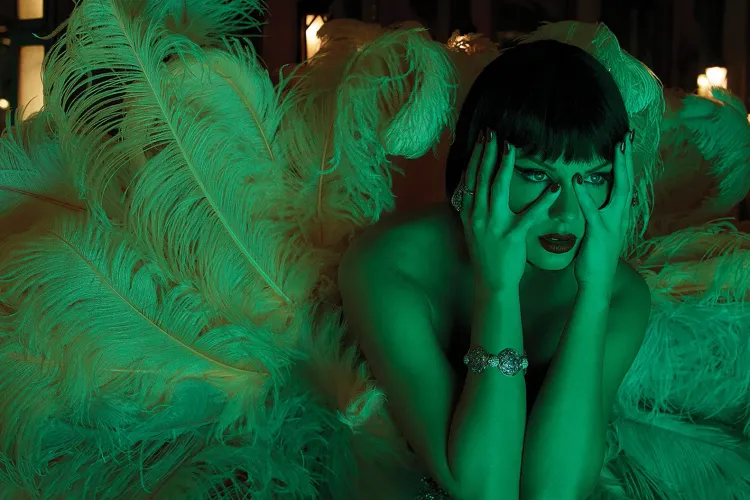Taylor Swift's evermore is a Christmas album

For many fans of popular music and even for many fans of Taylor Swift, evermore, released on Dec. 11, 2020, felt like a collection of B-sides from her hugely successful, Grammy-winning folklore, which had come out in July of 2020. And, yeah, I think no matter how much Swift tries to insist evermore is its own thing and she and her collaborators (particularly Aaron Dessner of The National, who co-wrote many of the albums' songs) just couldn't stop writing... evermore is pretty transparently a collection of folklore B-sides. They're good B-sides! Swift is a great songwriter! But you can see why most of them didn't make folklore.
And yet! Not only do I prefer evermore to folklore and not only do I think it's one of Swift's three or four best albums, but I think it's a tremendous Christmas album. And that latter statement is probably why I hold the former opinons, counter to the conventional wisdom though they may be. I don't think I prefer evermore because a lifetime of delivering takes on the internet has irreparably poisoned my brain into reflexively defending counterintuitive opinions.
One reason I respond to Swift's work so much is because her albums roughly correspond to particular seasons of the year, an idea that reverberates in my work, too. (Arden season one is a winter season, season two is a spring season, season three is a summer season, etc.) I suspect this quality stems from how often Swift wrote her early albums about specific relationships, which meant that elements of the timing of those relationships worked their way into her songwriting. And even though she's now been in a relationship with the same man for five years and is no longer writing songs about specific relationships that lasted for a handful of weeks or months, she's still utilizing seasonal imagery to achieve emotional effect, because it's a really great tool for doing so!
What's neat about folklore and evermore, then, is how hyper-specific they are in their feel. folklore seems to be an album pegged entirely to the month of August and specifically those last waning days before you have to go back to school. (Yes, the album has a song literally called "August," but the trio of songs about the doomed high school love affair also have big "Shit, I gotta go back to school with these people? Ugh!" energy.) But evermore seems to take place entirely across a visit back home (wherever home might be) for the holidays. It's not a concept album or anything like that, but its songs are loosely united by the idea of the intense melancholy that occurs when you're confronted by your past.
What I'm saying is I love this album because I didn't realize how much I needed art very specifically about being sad between December 22 and January 3. And while this month doesn't fall between those two dates, the album's title track nods toward "grey November." This is an end-of-year album for sure.
The most obvious example of the album's wistful holiday feel is its fourth track, which is literally called "Tis the Damn Season" and which is about hooking up with a high school lover because you're back home and kinda bored. It's a song almost designed to be included on indie-folk holiday playlists right alongside, like, Sufjan Stevens's cover of "Come Thou Fount of Every Blessing," and I can't wait for totally random covers of the song to start popping up on holiday albums in 10 years time. (I think it's inevitable this song will be covered on the all-but-certain Olivia Rodrigo Christmas Extravaganza.)
But burrow a little more deeply into evermore and you'll find it's an album about reconnecting with relationships that have gone a bit adrift. Across the album, Swift reflects on the aftermath of a friend's divorce ("Happiness"), remembers a deceased grandparent ("Marjorie"), and sees a relationship end at what I always imagine as a New Year's Eve party ("Champagne Problems"). She also considers the ways she's thankful for her long-term romantic partner ("Long Story Short"), contemplates moving into the woods to become a witch ("Willow"), and murders her friend's ex ("No Body, No Crime").
Do all of these events have to take place around the holidays? No. You can remember your beloved grandmother or comfort your friend at any time of year. But the occasional nods to end-of-year celebrations lend a subtle tinge of red-and-green wistfulness to the entirety of the album. And even though both folklore and evermore are very similar in terms of production, the former's instrumentation is lush, while evermore's is spare, in ways that befit their summer and winter cores, which is to say evermore feels a little like realizing all at once that there are no leaves on the trees anymore.
Song-for-song, folklore is probably slightly stronger than evermore, which has a couple of tracks I occasionally skip on relistens. But as a cohesive statement on a time of year and the feelings evoked by that time of year, I prefer evermore as an album.
Then again, of course I do. I love my holiday media to be soaked in melancholy and sadness. This is a time of year when we are reminded that the years continue to slide into the rearview mirror, and if you are a Sagittarius (AS TAYLOR SWIFT AND I ARE), then having this contemplative time of year stacked right up against your birthday, aka a literal reminder that you are another year older, can give the whole season a slate blue sense of something coming to an end, even as you know new things are about to begin, so long as you can hang on.
That's why I love Christmas so much. It's an acknowledgement that life is long and hard, but maybe if we pull together for a short while each year, we can make it less so. Yet even in the midst of that effort, the hangover from all of the things that are hard to bear doesn't go away entirely. evermore captures that, and I like to think Taylor Swift enjoys being sad at Christmas almost as much as I do.
Correction: The original version of this article stated that evermore was released on December 13, 2020. It was released on December 11. I sincerely regret the error.
Confidental to Taylor Swift: If you agree Christmas should be sad, pls say hi. (Also, happy birthday. I swear me posting this on your birthday was a total accident.)
Talk back to me: If you are not Taylor Swift but still agree Christmas should be sad, either post a comment or reply to the email!
What I've been up to: Another Succession, another chance for me to write about how America is watching that show incorrectly:
“Physically alive but spiritually dead” also describes an HBO character in a famously ambiguous final shot that may or may not depict the moment of that character’s death: Tony Soprano in The Sopranos’ series finale. The point of that show was always that Tony and his families (professional and personal) were forever bound by their self-centered, narcissistic choices and the psychological baggage they refused to unpack. We watched the entire show waiting for Tony to realize any of the ways he had screwed himself up, even a little bit, and the series finale was a long explanation of why he couldn’t change and never would. It doesn’t matter if he dies in the series’ final shot because he’s incapable of change and therefore already spiritually dead.
Also, if you like hearing me talk about being sad at Christmas, my wife (Libby Hill) and I are on the podcast Screen Drafts today to chat about Christmas-adjacent movies and how often the season gives them a perfect, melancholy vibe.
What you missed if you aren't a subscriber to Episodes: Sergio Lopez ran down the five albums (yes, only five) to top the charts in the year 1984 and argued for it as the best year in American pop music history. It's hard to argue with him, and I even appreciated his defense of (checks notes) Huey Lewis and the News.
In fact, Sports is a deeply enjoyable album, one that sounds best blasting at full volume on a hot summer day as you’re driving down the freeway. Two years later in 1986, Lewis would sing that it was “Hip to Be Square.” Sports is firmly in the same tradition. Indeed, Sports’ third track, “Bad is Bad,” with its playful chorus reminding us that “cool is a rule, but, sometimes, bad is bad,” can be read as a pre-emptive musical rebuke to Jackson, who in three years would release Bad, his follow-up to Thriller. (“Bad Is Bad” and Bad have nothing to do with each other, of course; Huey Lewis does not possess psychic powers.)
Read me: I was surprised with how much I enjoyed the new West Side Story, a film I simultaneously thought too beloved and too of its time to drag into the modern era. But Steven Spielberg and Tony Kushner (mostly) pulled it off! They even found a way to make Anybodys canonically trans without it being something the movie warped itself out of shape to deal with. Some of my Vox colleagues had similar thoughts in a roundtable discussion of the film.
The rest of the tragic backstory comes through courtesy of that Kushner screenplay. I have to agree with you, Alissa, that Kushner’s put together a model for this kind of adaptation. He preserves the original’s white-hot youthful yearning for some kind of release, through sex, through a dance at the gym, through a rumble. Heck, he even keeps in most of the “buddy boys.” But he also finds room to work some nuance into these archetypal figures. The Jets, with their ideology of resentment and displacement, become proto-Trumpists, directing their anger to those they consider outsiders rather than the city that’s razing their neighborhood to the ground. The Sharks, clearly, became an army out of sheer self-defense. And with that context, the whole story comes pulsing to violent life once again.
Watch me: Is it the holiday season? Then that means it's time to watch Christmas With Gordon Ramsay, the finest holiday special of them all! I check this out every year. I find it deeply soothing for reasons I cannot explain (though I tried last year at Vox).
And another thing... A recent screening of the Frederick Wiseman documentary The Store (a Christmas movie!!!) sent me down the rabbit hole of local department store history, which led me to a site named The Department Store Museum. It collects tales of department stores of yore, and it's honestly amazing. I have wasted so much time on here.
Opening credits sequence of the week: This is not strictly an "opening credits sequence," but oh my God, you have to watch the opening to Ken Berry's Wow Show, if only to just randomly see Steve Martin pop up. Then there's tap dancing!
A thing I had to look up: I did not have to look up Taylor Swift's birthday. I hope none of you ever doubted that I know it just off the top of my head!
This week's reading music: "How to Make Gravy" by All Our Exes Live in Texas
Episodes is published three times per week. Mondays feature my thoughts on assorted topics. Wednesdays offer pop culture thoughts from freelance writers. Fridays are TV recaps written by myself. The Wednesday and Friday editions are only available to subscribers. Suggest topics for future installments via email or on Twitter. Read more of my work at Vox.





Member discussion